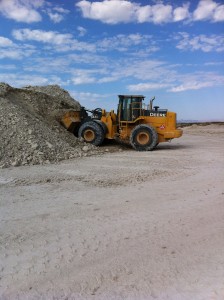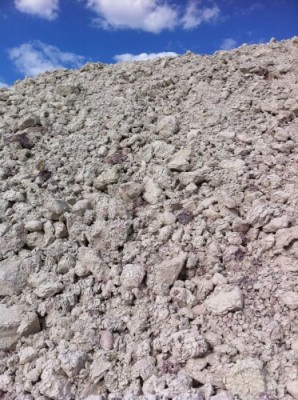What Is Sodium Bentonite & What Is It Used For?
 Small water bodies, such as lakes and ponds, frequently experience increased rates of water seepage and leaking into the soil around them. The soil in the pond bed and the surrounding sides of the pond can absorb or leak water, this resulting in diminishing the water level in the pond. Sodium bentonite is an effective pond sealant product that is extremely effective at preventing and stopping leaks in ponds. But, what is sodium bentonite?
Small water bodies, such as lakes and ponds, frequently experience increased rates of water seepage and leaking into the soil around them. The soil in the pond bed and the surrounding sides of the pond can absorb or leak water, this resulting in diminishing the water level in the pond. Sodium bentonite is an effective pond sealant product that is extremely effective at preventing and stopping leaks in ponds. But, what is sodium bentonite?
Understanding the answer to “What is sodium bentonite” can help you solve your pond leaking problems. Sodium bentonite, also known as bentonite clay, is often used as an earthen sealant for a variety of applications. Sodium bentonite is a natural substance that is used as a sealant in ponds, lagoons, and small lakes. Sodium bentonite can also be used to plug holes in wells, landfills, and even dams.
While sodium bentonite has many applications and uses where it is extremely effective, many individuals still wonder what is sodium bentonite and how it can effectively curb the issue of water seepage? To learn more about the answers to these questions and to buy clay bentonite products, contact us at Easley, Inc. online or by phone at 405-382-1973.
What Is Sodium Bentonite?
Western bentonite, a most unique industrial mineral, also has uncommon origins. Bentonite’s parent material, volcanic ash, is the direct by-product of plate tectonics. During the Cretaceous period, the North American plate drifted westward, forcing the eastern edge of the Pacific plate deep into the earth’s mantle.
 Soon a chain of volcanoes stretching from Mexico to southern Canada were spraying large quantities of ash and lava. During these near continuous eruptions, ash billowed up into high altitude winds. The prevailing winds carried the ash eastward. As the ash began to fall back to earth, it accumulated into deposits that can be seen today. A large inland sea, the Mowry Sea, occupied much of the central United States. Closed at the southern end, these waters stretched northward in a narrow body to the Arctic Ocean. This sea was shallow, calm, and somewhat stagnant due to a lack of regional currents to help circulation. It was also rich in dissolved minerals eroded from the surrounding landforms. The fine grained, glass-like ash particles fell into these waters and began reacting with the ocean’s minerals. As the ash accumulated on the sea bed, it is believed thermal currents helped to pile the material into “ash drifts.” This would explain why some bentonite beds are now found in random lenses, much like snow-drifts on a field after a blizzard.
Soon a chain of volcanoes stretching from Mexico to southern Canada were spraying large quantities of ash and lava. During these near continuous eruptions, ash billowed up into high altitude winds. The prevailing winds carried the ash eastward. As the ash began to fall back to earth, it accumulated into deposits that can be seen today. A large inland sea, the Mowry Sea, occupied much of the central United States. Closed at the southern end, these waters stretched northward in a narrow body to the Arctic Ocean. This sea was shallow, calm, and somewhat stagnant due to a lack of regional currents to help circulation. It was also rich in dissolved minerals eroded from the surrounding landforms. The fine grained, glass-like ash particles fell into these waters and began reacting with the ocean’s minerals. As the ash accumulated on the sea bed, it is believed thermal currents helped to pile the material into “ash drifts.” This would explain why some bentonite beds are now found in random lenses, much like snow-drifts on a field after a blizzard.
As the ash fall subsided, the only activity was the slow accumulation of sediment eroding from nearby landforms. Over the following millions of years, minerals from within the ash and elements in the sea water combined to form the intricate chemical lattice that makes bentonite so unique. Silt and mud accumulated into massive layers above this mineral-rich soup. The weight slowly compacted the bentonite beds into distinct layers within the Cretaceous formations.
Sixty million years ago a period of intense mountain building caused folding and raising of the North American plate. This action elevated the formations and drained the Mowry Sea. The rising land mass began drying up as water trapped within the formations migrated downward. This action further refined the ash by carrying dissolved silica out of the bed, down into the underlying mud. In the millions of years since, thousands of feet of sediment have eroded from these mountains re-exposing the bentonite layers.
So what is sodium bentonite? Particularly known for is its unique reaction when it comes into contact with water, sodium bentonite is a natural clay mined from the earth. Sodium bentonite, when moist, swells excessively and is able to absorb approximately 12 times its dry weight. As an extremely absorbent substance, it is no surprise that it functions extremely well as a sealant. In addition to being used an a natural earthen sealant, sodium bentonite is also used for lining structures such as landfills, during the process of drilling for natural oil and gas, and for any kind of water proofing.
In addition to these earthen sealant related applications, sodium bentonite can be used in a wide variety of additional applications. For example, some individuals also attribute healing properties to the clay-like substance claiming that it is also able to absorb harmful toxins through the surface of the skin.
Still Want to Learn More to Answer your Questions About What Is Sodium Bentonite?
When it comes to answering your questions about what is sodium bentonite, there is a lot of information that you can discover. As is one of the leading suppliers of sodium bentonite based out of Oklahoma, Easley, Inc. can answer all of your questions about sodium bentonite as a pond sealer and for other applications. Our high quality sodium bentonite is available in clay or granular form, depending on your intended application. Whether you are trying to avoid water seepage in a pond, or line a landfill site, sodium bentonite may be the solution for you.
Order Sodium Bentonite from Easley, Inc.
To learn more to answer your questions about what is sodium bentonite and its various uses or to place an order of any size, contact us at Easley, Inc. online or by phone at 405-382-1973.
